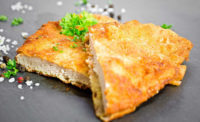Fried, crunchy nuggets beat out soggy, disintegrating ones every time. Too bad they aren’t the healthiest option for consumers — or at least, aren’t perceived that way. So what’s a fan of battered and breaded products supposed to do?
Fortunately, processors are developing new breadings and batters today that balance taste with health, by using techniques that still create a crispy batter while being low-fat, gluten-free and natural.
The balancing act, however, remains a work in progress due to the nature of the protein being used.
Take a breaded fish fillet, for example. The ideal product would have a nice crunch on the outside with a flaky, delicate texture on the inside. But seafood is inherently moist. So to keep the seafood’s moisture (especially when it is defrosting) from affecting its breading, processors have reduced the interface between the breading and fish.
Consumers have led the shift to low fat, low calorie and low sodium in their breaded fish fillets and sticks today, according to Donald Lynch, vice president of research & development and quality assurance, Gorton’s Seafood, Gloucester, Mass.
“Health is the biggest thing I focus on every day,” he says. “What’s new in seafood is what’s new for every category: healthier choices and more choices, in general. Consumers are trying to eat more seafood because it’s healthy, but they have a preconceived notion that breaded seafood is less healthy, although it’s low-fat and generally less than 200 calories.”
Starting with a healthier batch
For those consumers who just can’t give up their coated fish sticks and fillets, seafood companies are making it easier on them by offering healthier coatings.
“They are requesting low-fat items, so that means we have to prevent fat pick-up when the product is being fried,” he says. “And consumers want companies to focus on reducing sodium, but still deliver the same taste and crunch.”
Little eaters’ meals are also being affected, because their parents want them to have a healthier product as well, so sticks or fillets can now have whole grains in their coatings.
In addition, “we have also seen a push for breadings and batters to be lightly coated on products, so they offer the same flavor but with less coatings,” Lynch says. “Less coatings have less oil pick-up.”
These coatings are also expected to have as few allergens in them as possible, such as soy, eggs and dairy, and, in Canada, mustard, says Lynch.
Making it stick
Frozen battered products, in particular, have plenty of ordinary challenges to struggle with every day, such as proper adhesion of the breading to the product and delivering a faster, more convenient cooking process.
“Consumers always want to speed up the cooking process, but it’s hard to deliver the same quality in the microwave as … in the oven,” says Lynch. It’s also hard (and perhaps not as healthy) to duplicate the flavor of the local pub at home, but consumers are requesting that processors try.
“People want restaurant quality at home, but a lot goes on at restaurants to deliver a great-tasting product and experience,” says Lynch. Nevertheless, they are trying, he notes; many are offering beer-battered fish, for example, as a way to reach that standard.
Removing gluten and fat
Further down the frozen-food case, Tyson Foods and Perdue Farms have recently launched gluten-free products. In early 2013, Tyson rolled out gluten-free chicken nuggets and chicken strips, made with all-white meat and natural (minimally processed) ingredients. Perdue introduced gluten-free chicken nuggets in 2012.
Other processors such as Applegate Farms and Bell and Evans launched gluten-free offerings three to six years ago.
They are all responding to consumer demands for more gluten-free ingredients — and clean labels featuring natural and whole-grain ingredients.
“Gluten-free, natural and whole grains will only continue to become more popular,” says Casey Owens-Hanning, Ph.D., associate professor, Poultry Science, University of Arkansas, Fayetteville, Ark.
Low-fat breadings and batters are still popular with poultry products as well. These coatings are made using several different methods, such as oven-baking which reduces the oil pick-up from fryers.
However, oven-baking sounds healthier than it may actually be, notes Owens-Hanning. Oven-baked products are first fried before being baked, because the fryers provide a desired texture to the chicken products.
“Some local plants are even switching back to only fryers to get the texture they want,” she says.
Another way to reduce oil pick-up is by using starches and other ingredients that block absorption. But as always, there are trade-offs between quality, texture and cost.
“If you add extra ingredients,” says Owens-Hanning, “you won’t get the traditional texture, and costs will go up.”
If processors reduce the amount of sodium in their products, they have to maintain strong flavor with other flavors in the interior layer, she says, or the product will be too bland.
Surviving the freezing process
During the freezing process, there can be a moisture migration from the protein to the breading, causing the mushy coating that no one likes.
“Texture is a big challenge for frozen products that have to be reconstituted,” she says, such as in the microwave. The reconstitution process can lead to a frozen poultry product leaving the microwave too mushy or hard.
“That’s our challenge: how do we reconstitute products quickly and effectively?” says Owens-Hanning. To add flavor and change texture, many processors are adding glazes and sauces to some products, particularly appetizers.
“They do change the flavor of the product, but do people want to deal with the stickiness and mess?” she says.
At the end of the day, a lot of research goes into blocking fat uptake in breading but at the possible expense of taste, and with additional costs. Yet, so long as consumers want and request these changes, processors will try to meet their needs.
“But it is always a challenge to bring the final product back to the gold-standard taste of a fried nugget,” says Owens-Hanning.







Report Abusive Comment